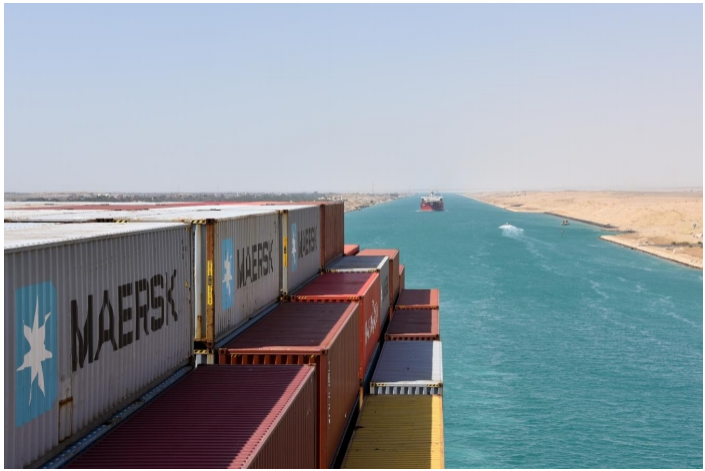
Ocean carriers are adding surcharges to deal with the longer transit times and the higher operating costs that result.
Maersk and CMA CGM have teed up close to 200 container ships that will bererouted away from the Suez Canal and instead use the longer transit around southern Africa’s Cape of Good Hope, according to notices from the ocean carriers. The diversions will create delays along ocean supply chains between Asia, Europe and the US East Coast and further increase costs as carriers pass on more risk-related surcharges to shippers.
In an advisory Friday, Maersk listed 155 ships on multiple Asian services to Europeand the US East Coast that will be diverted due to the “ongoing situation around the Red Sea.” Maersk noted that some diversions are contingent only, and subject to change.
The diversions are being driven by accelerating attacks against commercial shipping in the form of missiles and drones launched by Houthi rebels from southern Yemen, an extension of the Israel-Hamas war in Gaza. The US this week announced the creation of a multinational naval force to thwart the attacks and restore security to the Red Sea and Gulf of Aden.
Most of Maersk’s diversions are on Asia-Europe services, with some 84 vessels across eight different service strings being affected. As Maersk’s partner in the 2M Alliance, Mediterranean Shipping Co. also operates many of the vessels in those services.
Most of those ships will see transit times increase, according to the expected departure and arrival dates for the ships listed. 2M’s Asia-Europe 5 (AE5) service, which had a total of 12 ships in both directions diverted, is seeing the westbound transit time from Malaysia’s Tanjung Pelepas to Rotterdam increase anywhere from five to nine days above its 22-day transit.
Maersk lists diversions for vessels that are expected to depart well into February.
Another 48 vessels spread across four Asia-US East Coast services offered by 2M are also being diverted, Maersk said. Many of those diversions will initially affect eastbound cargo out of the US as two services use the Suez only for the return trip to Asia, with the Panama Canal serving as the inbound route to the US.
Maersk said 13 ships scheduled to depart out of the Port of Baltimore through Feb. 25 will take the Cape of Good Hope route to Oman’s Salalah port on its Transpacific 12 service (TP12), adding about five days to the normal 21-day transit through the Suez. Likewise, all 12 ships on itsTP16 service will see departures from Newark to Singapore diverted via southern Africa through the end of February, adding three to five days to the voyage.
CMACGM ‘deeply concerned’
Maersk’s announcement follows a service advisory from CMA CGM on Thursday that it’s invoking a clause in its bill of lading to reroute some ships via the Cape of Good Hope because it’s “deeply concerned about the recent events in the Red Sea.”
The notice listed 22 ships. Those diverted include five ultra-large container vessels used in its French Asia Line (FAL) 1 and 3 services. CMA CGM’s two India-America express (INDAMEX) services to the US East Coast will see five ships diverted, while four ships in the carrier’s largest-capacity US East Coast service, the Columbus Jax, will see four ships diverted.
Along with the schedule changes, ocean carriers are adding surcharges to deal with the longer transit times and the higher operating costs that result. Hapag-Lloyd announced on Friday two additional surcharges that referred specifically to the situation in the Red Sea. Among those charges are an “emergency revenue charge” of $1,000 to $4,000 for various types of containers going to and from ports in the Red Sea that will be in effect through the end of the year, Hapag-Lloyd said.
It also said shippers will face a “contingency surcharge” of $500 per TEU starting Jan. 21 on shipments between North Europe and the Americas. Hapag-Lloyd said the surcharge is necessary because the Suez diversions “will impact schedules and equipment supply in the Atlantic trade, resulting in significantly higher cost.”
Hapag-Lloyd is also seeking to push through an “operations recovery surcharge” of $800 to $1,000, depending on container type, for shipments between the Indian subcontinent and Mideast Gulf and the US East and Gulf coasts.
Maersk services and number of ships diverted
Asia-Europe 5 (AE5) – 12
Asia-Europe 6 (AE6) – 9
Asia-Europe 7 (AE7) – 11
Asia-Europe 10 (AE10) – 11
Asia-Europe 11 (AE11) – 14
Asia-Europe 12 (AE12) – 11
Asia-Europe 15 (AE15) – 9
Asia-Europe 55 (AE55) – 7
Middle East 2 (ME2) – 7
Middle East 6 (ME6) – 7
Middle East 7 (ME7) – 9
Transpacific 11 (TP11) – 11
Transpacific 12 (TP12) – 13
Transpacific 16 (TP16) – 12
Transpacific 17 (TP17) – 12
CMACGM services and number of ships diverted
Chesapeake Bay Express (CBX) – 1
Columbus Jax (CLX) – 4
Europe Pakistan India Consortium (EPIC) – 1
French Asia Line 1 (FAL1) – 3
French Asia Line 3 (FAL3) – 2
India-America Express (INDAMEX) – 3
India-America Express 2 (INDAMEX2) – 2
Mediterranean Express (MEDEX) – 1
Mediterranean Club Express (MEX) – 1
Pacific Express 3 (PEX3) – 3
Phoenician Express (BEX2) – 1

